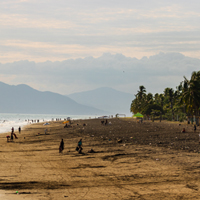Public Transportation in San Jose
Summary: Learning how to get around using public transportation in San Jose is an important step in adjusting to life in San Jose. In this article, we cover the local public transportation options.
San Jose, is a vibrant city that attracts digital nomads from all over the world with its rich culture, tropical climate, and affordable cost of living. Navigating the city can be an adventure in itself, and understanding the public transportation options available is essential for any digital nomad looking to explore or settle in the area. From traditional buses to modern ride-sharing apps, there are several ways to get around without the need for a personal vehicle.
Buses
The most common and economical way to travel around San Jose is by bus. The city has an extensive network of buses that can take you to nearly every corner of the metropolitan area and beyond. Buses are frequent, though peak hours can lead to crowded conditions. Fares are relatively cheap, and routes cover major points of interest, residential areas, and business districts. For route information and schedules, you can visit the official bus company websites, such as Transitobus or Ticabus, which provide details on their respective services.
Trains
While not as extensive as the bus system, San Jose's train service is a viable option for avoiding traffic during rush hours. The Instituto Costarricense de Ferrocarriles (INCOFER) operates several train lines that connect key areas of the city, including a route that runs from Heredia to San Jose. The trains are relatively punctual and offer a comfortable ride, though they can be infrequent outside of peak times. For schedules and fare information, digital nomads can visit the INCOFER website at INCOFER.
Taxis and Ride-Sharing
Taxis are a convenient option for those looking for a direct route to their destination. They can be hailed on the street or found at taxi stands throughout the city. Official taxis are red with a yellow triangle on the side, and they are equipped with meters (called "maria") to calculate the fare based on distance traveled. For a more modern approach, ride-sharing apps like Uber and Didi are also available in San Jose, offering a user-friendly experience with fare estimates and cashless transactions.
Bikes
For the environmentally conscious digital nomad, biking is a great way to get around San Jose. The city is making efforts to become more bike-friendly, with dedicated lanes and bike-sharing programs slowly being introduced. Biking is ideal for short distances and can be a pleasant way to explore the city's neighborhoods and parks. However, it's important to stay alert as traffic can be heavy and not all drivers are accustomed to sharing the road with cyclists.
Helpful Apps
Technology can greatly enhance the public transportation experience in San Jose. Apps like Moovit and Google Maps provide real-time transit information, including bus and train schedules, route planning, and service alerts. For ride-sharing services, Uber and Didi have their own dedicated apps that are widely used in the city. These tools can help digital nomads efficiently plan their travel and make informed decisions about the best routes to take.
Safety
When using public transportation in San Jose, safety should always be a priority. It's advisable to keep an eye on personal belongings, especially in crowded buses or trains. Avoid traveling alone late at night and stay in well-lit, populated areas when waiting for a bus or train. Taxis and ride-sharing services offer a safer alternative during the night. It's also recommended to learn some basic Spanish phrases for communication and to be aware of the local emergency numbers in case of any incidents.
San Jose's public transportation system is a cost-effective and authentic way to experience the city. By staying informed and using the resources available, digital nomads can navigate San Jose with confidence, making the most of their time in Costa Rica's bustling capital.
About the Author
 Joshua Wood, LPC is one of the Founders of Digital Nomad Exchange and serves as Co-President of Expat Exchange. Prior to Expat Exchange and Digital Nomad Exchange, Joshua worked for NBC Cable (MSNBC and CNBC
Primetime). Joshua has a BA from Syracuse and a Master's in Clinical and Counseling Psychology from Fairleigh Dickinson University. Mr. Wood is also a licensed counselor and psychotherapist.
Joshua Wood, LPC is one of the Founders of Digital Nomad Exchange and serves as Co-President of Expat Exchange. Prior to Expat Exchange and Digital Nomad Exchange, Joshua worked for NBC Cable (MSNBC and CNBC
Primetime). Joshua has a BA from Syracuse and a Master's in Clinical and Counseling Psychology from Fairleigh Dickinson University. Mr. Wood is also a licensed counselor and psychotherapist.
Some of Joshua's articles include Pros and Cons of Living in Portugal, 10 Best Places to Live in Ireland and Pros and Cons of Living in Uruguay. Connect with Joshua on LinkedIn.

AGS Worldwide Movers can move you to and from anywhere in the world.
Get Quote
 Digital Nomad Visa for Costa Rica
Digital Nomad Visa for Costa Rica
Learn about the Digital Nomad Visa for Costa Rica and what is involved in obtaining one. This is one of the most important aspects of moving to Costa Rica as a digital nomad.
![]() Costa Rica Forum
Costa Rica Forum
Talk with other digital nomads and expats in Costa Rica on our Costa Rica forum - meet people, get advice and help others.
![]() Contribute
Contribute
Help others in Costa Rica by answering questions about the challenges and adventures of living in Costa Rica.
Digital Nomads in Costa Rica offer advice about healthcare, hospital visits, emergency rooms visits, finding a doctor and buying health insurance in Costa Rica.




